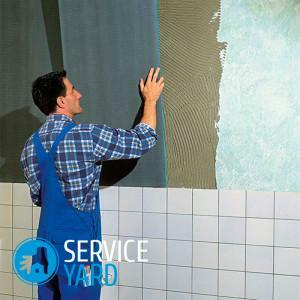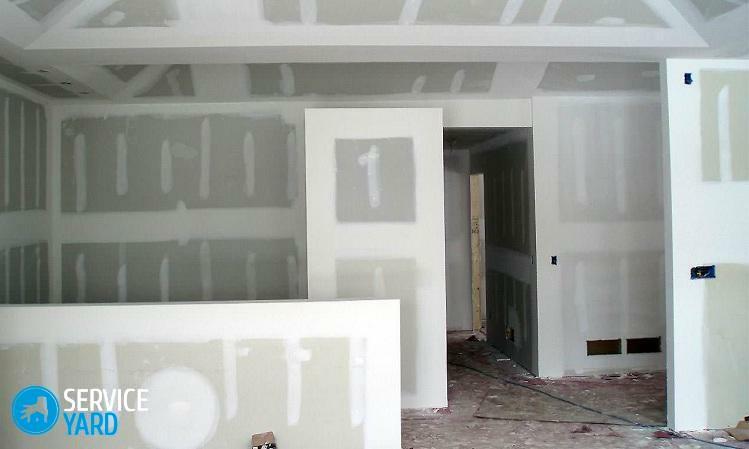
- Features of using GKL
- Frame-type VS frameless method - what is more preferable?
- Required tools
- Kinds of drywall
- Cutting order
- Mixture for installing drywall on a wall without a frame
- Foam mounting
- How to coat a wall with plasterboard without a frame - mounting
Drywall is one of the most sought after finishing materials due to numerous advantages:security, the possibility of use in a variety of rooms and a relatively low price. Let's talk about whether it is possible to wall plasterboard without a frame.
to content ↑Features of GKL
Drywall is used to mask the unevenness of walls and the construction of partitions. At the same time, not only an experienced builder can work with this material, but also not a very experienced master. Installation is possible on various adhesive compositions and base surfaces.
Important! The advantage of this method in front of the skeleton is that the useful volume of the room is "eaten up" to a much lesser degree. At the same time, the laboriousness of the finishing works is small and can be made independently.
to the contents ↑Framed VS frameless way - what is more preferable?
For the sake of justice it is necessary to say that sometimes the installation of gypsum boards on the frame is the only way of finishing. Let's try to compare these two fundamentally different methods and determine the scope of their application.
Frame method
For the manufacture of skeletons used metal profiles or wooden beams. This method is used if additional thermal and sound insulation of the room is needed. Use the installation of sheets on the frame and in the event that the walls are uneven, and they can not be leveled with plaster.
Frameless method
The installation of plasterboard on walls without a frame is made on a gluing composition with gypsum or on construction foam and self-tapping screws:
- Gypsum bonding compound is preferable for concrete and brick walls.
- Fastening of gypsum boards with self-tapping screws is used for wooden walls.
Important! There is a restriction on the height of the walls( it should not exceed 3.0 m).
to content ↑Tools required
To align the walls without prefabrication of the frame, the following tools are used:
- A construction level of 1.5 m in length - to control vertical planes.
- Electric jigsaw - for the preparation of gypsum boards.
- A set of marking tools: a pencil, rulers, squares.
- Spatulas of different widths for the application of mortar.
- Grater for construction.
- Paint roller and brush - for applying soil.
- Rubber hammer.
- Electric drill with a nozzle-mixer.
- Screwdriver - if you need to fix the sheet also on the screws.
You will need materials from the materials:
- Primer with antiseptic.
- Base and finishing putty on a gypsum base.
- Construction foam or special adhesive for gypsum board.
- Tape made of a mesh-serpian to hide joints between sheets.
- Self-tapping screws. Their length depends on how smooth the surface is. The depth of penetration of self-tapping screws into the wall is from 50 to 60 mm.
- Foam( optional).
Types of drywall
One of the best is Knauf's products. The company is engaged not only in the production of construction and finishing mixtures, but also in plasterboard with different applications:
- Conventional - it is used for premises with low humidity.
- Waterproof - used for bathrooms and toilets. On this surface is perfectly installed tile.
- Fire-resistant. Great for a fireplace area, near an oven and / or a chimney.
- Fire-resistant. Suitable for finishing walls in attics, attics or a boiler house in a private house.
Important! To cut a sheet of drywall is a pleasure. No special devices are needed. A well-ground clerical knife.
to the contents ↑The cutting order of the
This process will have to be carried out in any case, regardless of whether it is planned to wall plasterboard without a frame or with it. The gypsum board is cut in this order:
- Place the sheet on a flat horizontal base.
- Mark the sheet using a ruler or tape measure, draw the necessary lines with a pencil.
- Using a ruler, draw a knife along the outlined line.
- Slide the sheet over the surface, lay it along the cutting line.
- Click on the edge of the sheet and crack it.
- Cut the cardboard from the other side of the sheet.
Mixture for installation of drywall on a wall without a frame
This composition is produced on a gypsum basis with plasticizers, which provide strength and good adhesion of the solution. Any adhesive mixture for frameless installation must satisfy the following requirements:
- Minimum setting time.
- Slight shrinkage when hardening.
- Uniformity and ductility.
- Easy to apply.
Important! Please note that the gypsum mixture is not overdue, since it has a short shelf life - usually no more than six months. It is undesirable to acquire the mixture in bulk.
The time to use the finished solution is about half an hour, so it is better to cook it in small portions. If the mixture begins to set, it can not be diluted.
Important! Experts advise buying all the materials for wall plastering with plasterboard on glue from one manufacturer( the same "Knauf"), as they perfectly interact with each other.
to Contents ↑Foam Foam
This is a fairly popular material, and its different types have different characteristics. Different foams have a different coefficient of expansion, so do not forget to ask their characteristics in advance. There are 2 types of mounting foams:
- One-component, ready-to-use polyurethane formulations. They are sold in cans.
- Two-component. These mixtures are used by professionals, because for their preparation requires special equipment and exact observance of proportions.
Advantages of using mounting foams are as follows:
- Good adhesion with a wide variety of materials.
- Material resistance to temperature changes.
- Foam is a dielectric - it does not have electrical conductivity.
- Good sound insulation properties.
- Ease of installation, fast freezing.
- No toxic substances.
- Flameproof.
- Water resistance.
- Small( no more than 5%) shrinkage.
- High strength.
- Good thermal insulation effect.
- Plasticity, elasticity, filling gaps and gaps.
How to coat walls with plasterboard without a frame - performing assembly works
The whole cycle of works for plasterboard walls is divided into several stages.
Preparation of
The first stage is the qualitative preparation of surfaces:
- If the wall is painted with oil paint or enamel, which "do not tear off and teeth", make the entire surface of the notch to ensure better adhesion. For this purpose a perforator with a nozzle or an ax is suitable.
- Be sure to seal the cracks and cracks on the walls. Fill them with a mounting foam, and after it has solidified, remove the excess with a sharp knife.
Important! For small defects, a cement-sand mortar is also suitable.
- Clean the surface of the wall from dust using a wide brush or vacuum cleaner.
- Treat the wall with a primer with an antiseptic. This not only significantly improves adhesion, but also prevents the development of fungus, mold, the appearance of harmful insects. Leave the used wall to dry completely.
- After the wall is dry, check its verticality with the help of a construction level or a plumb line. If there are significant distortions, the wall will have to be leveled.

Aligning
There are several ways to align the walls.
Method 1
To implement it, you need a gypsum adhesive and pieces of gypsum board( kind of beacons):
- The pieces can be square or made in the form of strips.
- The number of them depends on the degree of unevenness of the wall.
- Having determined the highest and lowest points on the wall, output the last one to a single level with the first one.
- Now it remains to accurately output the remaining surface.
Important! Sometimes the lining of plasterboard is done in 2 layers. The beacons fixed on the solution after solidification of the solution serve as a support for the finishing sheets.
Method 2
As in the first method, start the alignment by finding the "maximum and minimum" points. Then start screwing into the wall screws at intervals of 20-30 cm so that their hats are at the same level.
Important! In this case, self-tapping screws serve as a support for gypsum boards. Mount the sheets on the gluing composition, and you will have an ideally vertical wall.
Installation of drywall on construction foam
This method is suitable for uneven walls. In addition, it makes it possible not to overly tighten the finishing work.
First, primetute and dry the wall well, and then:
- Mark 8-9 points on the sheet, along which it will be attached to the wall.
- Drill holes for self-tapping screws.
- Place the sheet against the wall and mark it with slits.
- Remove the sheet, and from the marks in the wall, drill a hole 5-6 cm deep under the dowels.
- Screw the plugs into the wall holes.
- Stick on the opposite side of the sheet 12-15 pcs.square pieces of foam rubber 15x15 cm. The thickness of the foam is 1.5-2.0 cm. If there is considerable distortion, it is desirable to paste the foam on the wall. The distance of foam rubber from dowels is from 10 to 12 cm. Foam pieces in this case serve as shock absorbers.
- Attach the sheet to the wall by screwing the screws through pre-prepared holes. Constantly monitor the correct attachment, using the building level.
- Do the same with all the sheets.
- After completing the installation, drill a hole 7-8 mm at a distance of 2-3 cm from each of the self-tapping screws. Through the holes, pour a mounting foam into the space between the wall and the gypsum cardboard sheet.
Important! The freezing time of the foam in this case is not less than 24 hours, as the process passes without air.
- Surplus of construction foam, which came out through the holes, gently cut with a knife.
- After the foam is frozen, unscrew the screws. They are no longer needed.
- Reinforce the joints between the sheets with a serpentine tape, and then work with putty. After the putty dries, treat the joints with sandpaper or a mesh of abrasive material.
- Soak, pad and dry the wall, then smooth it to make the surface smooth.
The wall is ready for decorative finishing!
As you can see, mounting GKL on the wall is not so difficult. And do not need to call a master to change the geometry of the room or recreate in it an intricate idea of decor.
